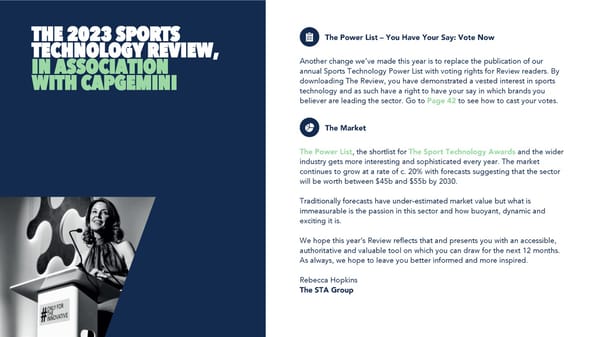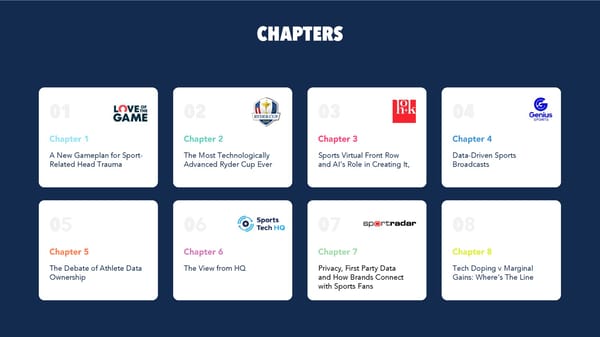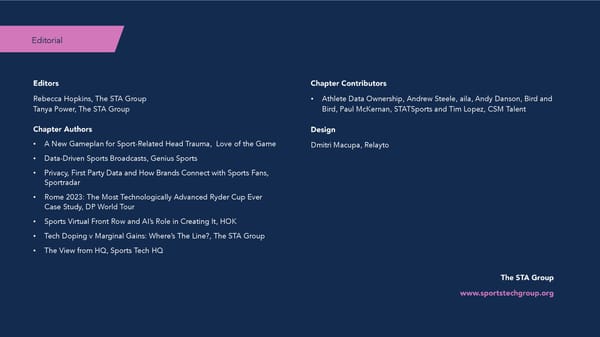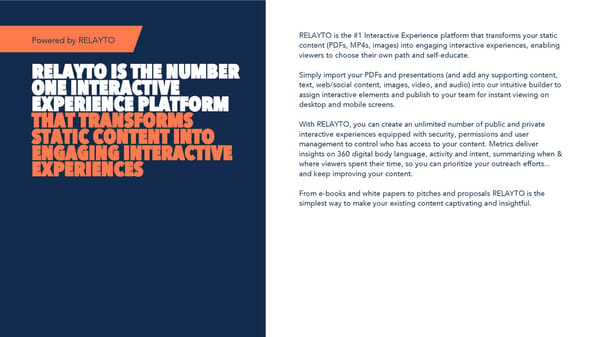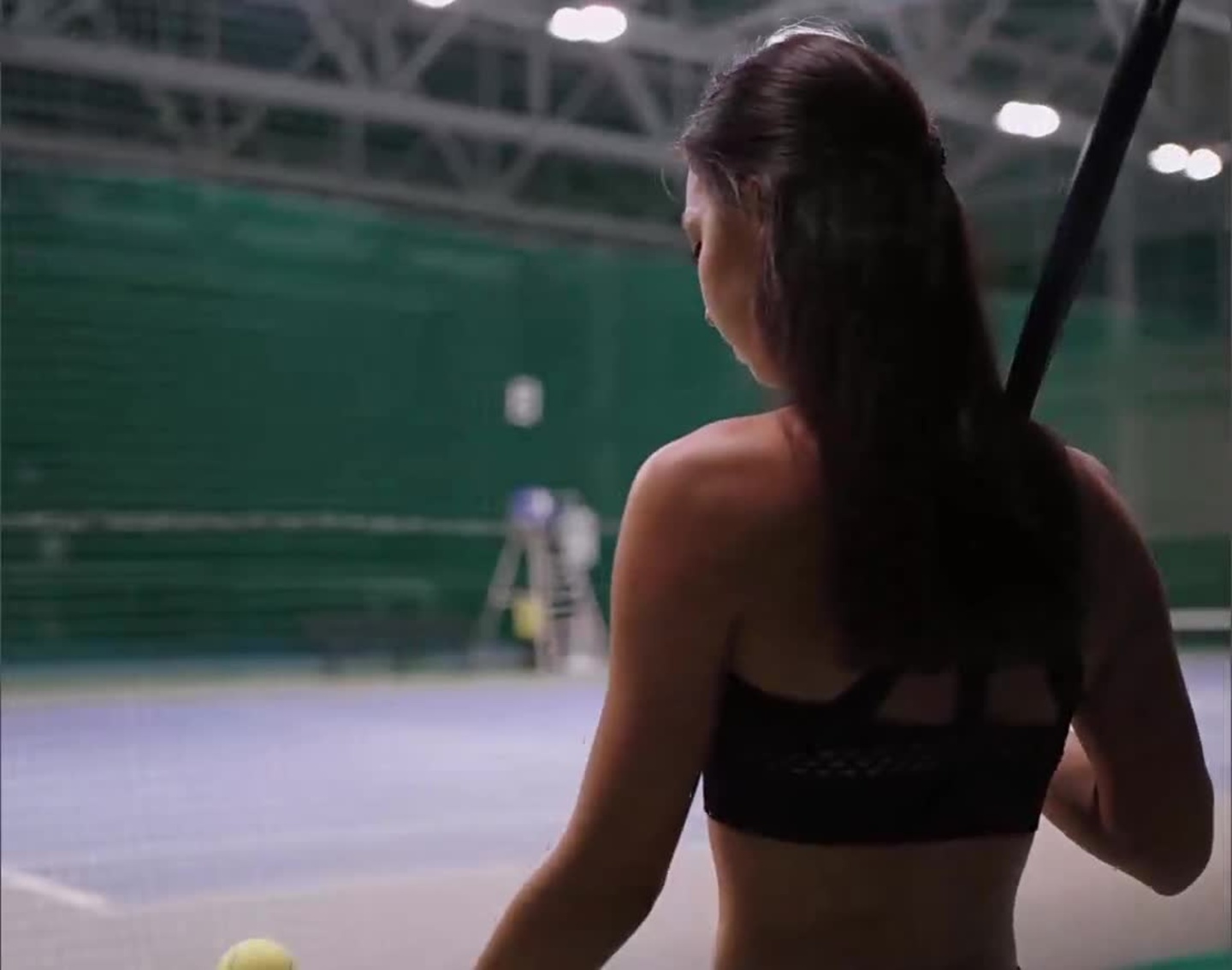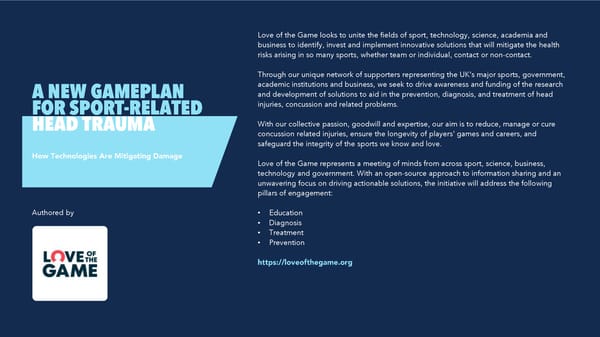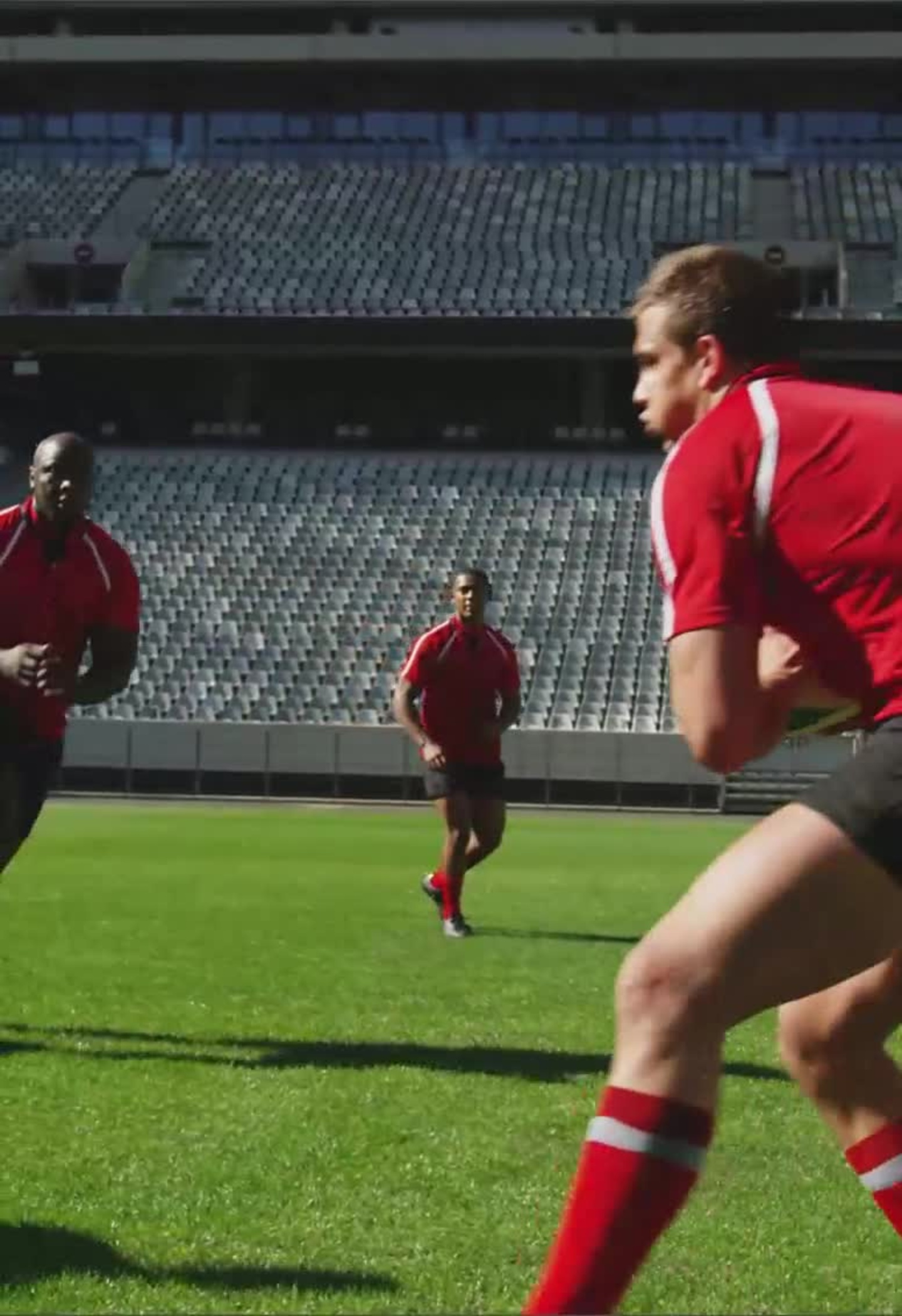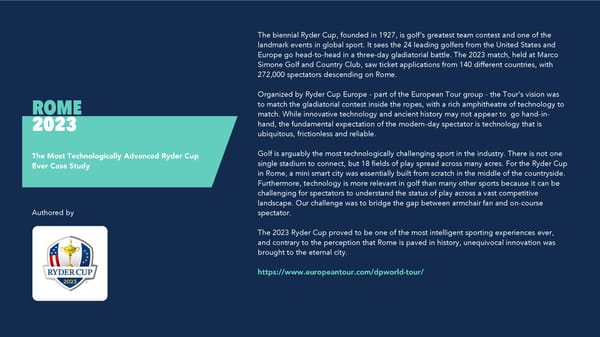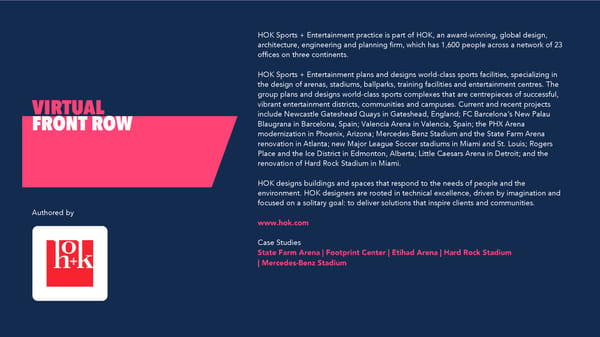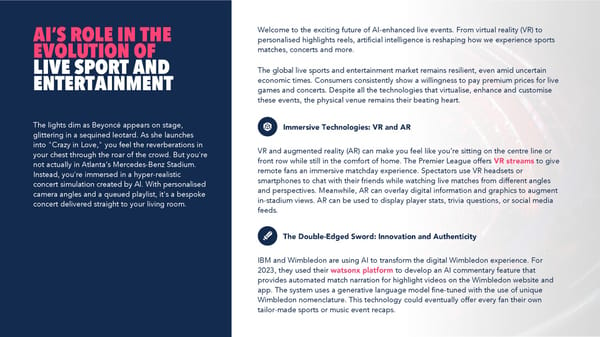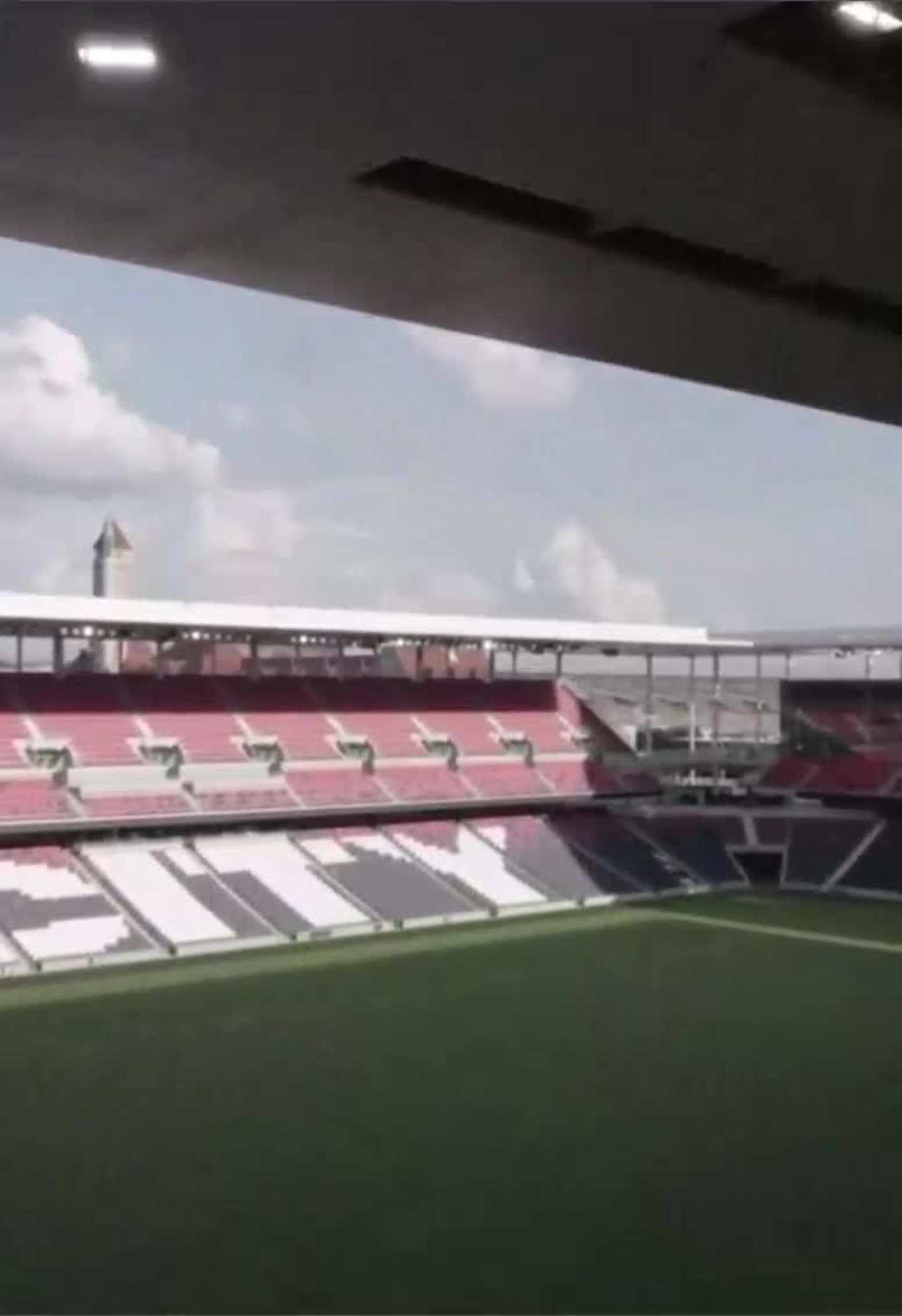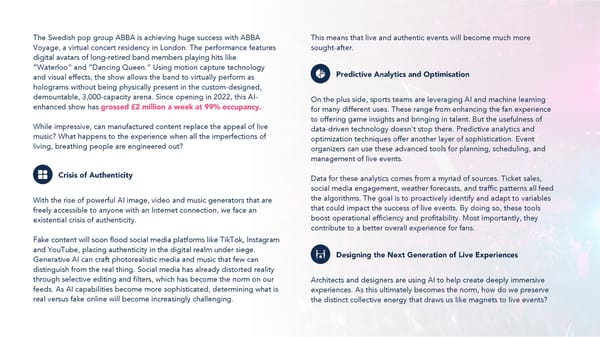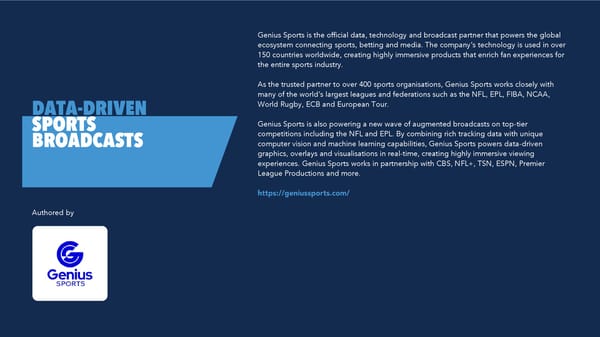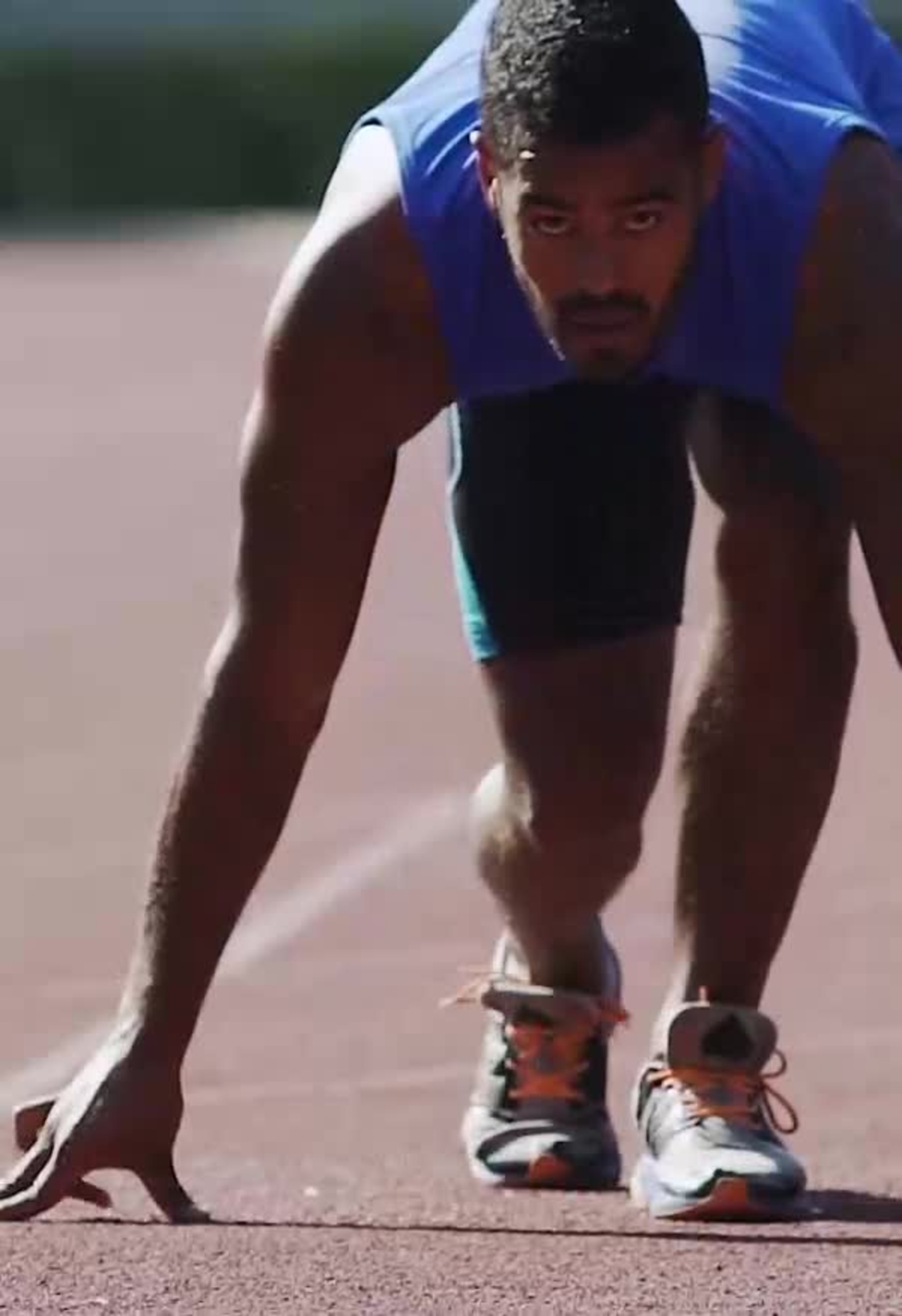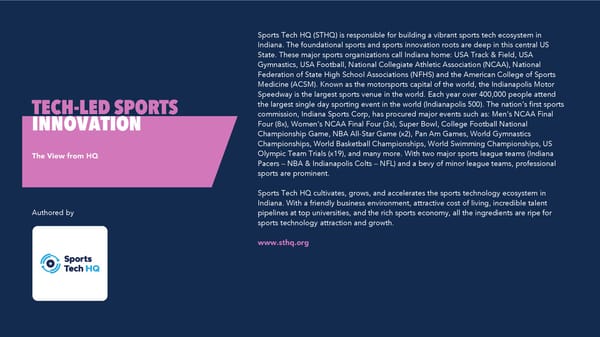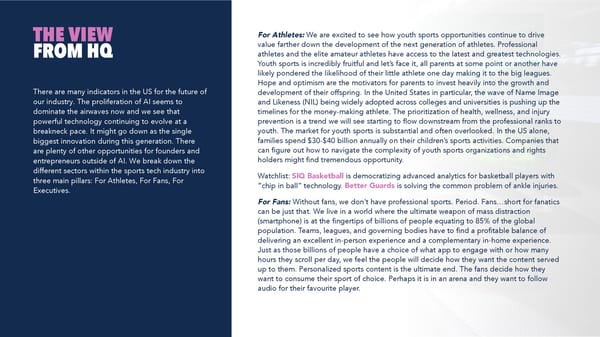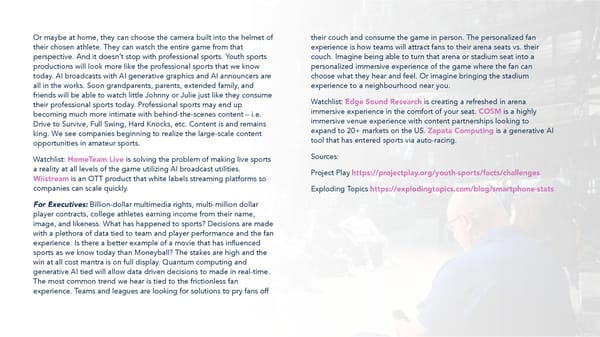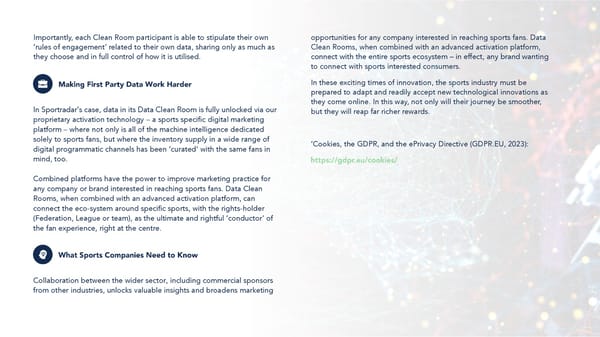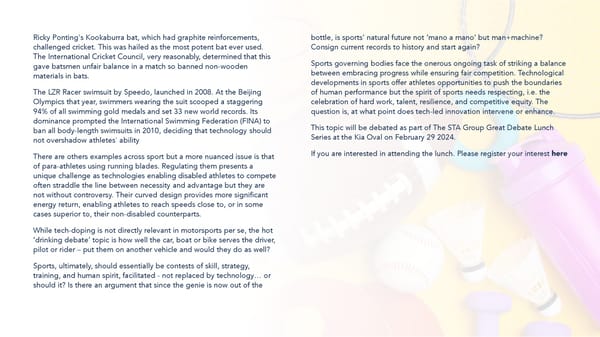The Sports Technology Annual Review 2023
THE SPORTS TECHNOLOGY ANNUAL REVIEW
Introduction Our aim for The Review is to summarize and explain some of the most Introduction influential and important tech-related trends in sports for those with a professional stake in the sector. This is The Review’s fourth edition and, as with previous years, the chapter subjects are selected to fast-track senior WE ARE DELIGHTED TO sports executives through topics that might not be featured in mainstream BRING YOU sports and business media. THE 2023 SPORTS TECHNOLOGY REVIEW We are delighted that The 2023 Review is being brought to you in association with our Innovation Partners, Capgemini. We have been proud to work with them for three years, primarily as the Innovation Category Sponsor of The Sports Technology Awards. This places them at the heart of sports innovation, meaning they are very aware of the work being done by sports sector visionaries, which is something they bring to their clients and partners, both in and outside sports. Our ambition is to offer insight, not just data. Through publishing this report via Relayto, we believe we offer more value as the format includes embedded videos and links at relevant points. This means that any reader looking for more intelligence can find it easily.
THE 2023 SPORTS Introduction TECHNOLOGY REVIEW, IN ASSOCIATION Another change we’ve made this year is to replace the publication of our annual Sports Technology Power List with voting rights for Review readers. By WITH CAPGEMINI downloading The Review, you have demonstrated a vested interest in sports technology and as such have a right to have your say in which brands you believer are leading the sector. Go to to see how to cast your votes. , the shortlist for and the wider industry gets more interesting and sophisticated every year. The market continues to grow at a rate of c. 20% with forecasts suggesting that the sector will be worth between $45b and $55b by 2030. Traditionally forecasts have under-estimated market value but what is immeasurable is the passion in this sector and how buoyant, dynamic and exciting it is. We hope this year’s Review reflects that and presents you with an accessible, authoritative and valuable tool on which you can draw for the next 12 months. As always, we hope to leave you better informed and more inspired. Rebecca Hopkins
CAPGEMINI IS AN To achieve our mission, we must maximize our potential. We use the values of Introduction sport to enhance our ability to work as one, to inspire each other, to constantly ORGANIZATION DRIVEN innovate and never accept second best. BY THE BELIEF THAT Sport inspires our clients and our employees. Together we share a TRANSFORMATION huge passion for sport. SHOULD BENEFIT ALL Through our global partnerships with sports organizations, including World OF HUMANITY FOR Rugby, Ryder Cup and Peugeot Sport – as well as The STA Group, Capgemini is THE LONG TERM helping to transform sport through technology and innovation. Capgemini's partnership with World Rugby is helping to make the sport more inclusive and sustainable, through the introduction of new technological solutions at the Rugby World Cup France 2023, creating a more inclusive pathway for female leaders in rugby, and helping World Rugby to embed sustainability into its operations. Likewise, our partnership with Ryder Cup, one of the most tactically demanding events in golf, aligns perfectly with our expertise in using strategic insights to transform businesses. And the partnership with Peugeot Sport plays a key role at the heart of the FIA World Endurance Championship program, driving transformation with advanced digital tools and analytics to enhance the performance of the team and the Peugeot 9X8. Sport provides a platform to demonstrate our expertise in using the power of transformative technology and innovation to achieve true impact and value. Capgemini is committed to sport, not just because of our shared passion but because we know it can bring people together to make a real difference. This is the reason Capgemini is delighted to be associated with The 2023 Sports Technology Annual Review.
CHAPTERS 01 02 03 04 A New Gameplan for Sport- The Most Technologically Sports Virtual Front Row Data-Driven Sports Related Head Trauma Advanced Ryder Cup Ever and AI’s Role in Creating It, Broadcasts 05 06 07 08 The Debate of Athlete Data The View from HQ Privacy, First Party Data Tech Doping v Marginal Ownership and How Brands Connect Gains: Where’s The Line with Sports Fans
Editorial Rebecca Hopkins, The STA Group • Athlete Data Ownership, Andrew Steele, aila, Andy Danson, Bird and Tanya Power, The STA Group Bird, Paul McKernan, STATSports and Tim Lopez, CSM Talent • A New Gameplan for Sport-Related Head Trauma, Love of the Game Dmitri Macupa, Relayto • Data-Driven Sports Broadcasts, Genius Sports • Privacy, First Party Data and How Brands Connect with Sports Fans, Sportradar • Rome 2023: The Most Technologically Advanced Ryder Cup Ever Case Study, DP World Tour • Sports Virtual Front Row and AI’s Role in Creating It, HOK • Tech Doping v Marginal Gains: Where’s The Line?, The STA Group • The View from HQ, Sports Tech HQ
The Glossary An area of computer science that emphasizes the creation of intelligent machines that work and react like humans. A set of rules to be followed while problem-solving or data processing in a specific order. A technology that overlays digital information onto the real world, enhancing user interaction with their environment. The measurement and statistical analysis of a person's physical and behavioural characteristics, often used for identification and access control. A decentralized and distributed digital ledger system, popularly used for the secure transaction, agreement, or contract validation. The process of discovering patterns in large data sets through the use of algorithms and machine learning. A secure, privacy-safe environment where advertisers and marketers can analyze and measure data without directly accessing it. A subset of AI involving artificial neural networks with several levels of nodes, mimicking the human brain, to solve complex problems. In the context of sports, it refers to the illegal use of substances to improve athletic performance. In electronics, it's the process of adding impurities for modifying material's properties. Competitive, organized video gaming allowing multiplayer competitions often between professional players. Data that a business collects directly and ethically from its own sources such as websites, apps, CRM systems, surveys, and physical stores.
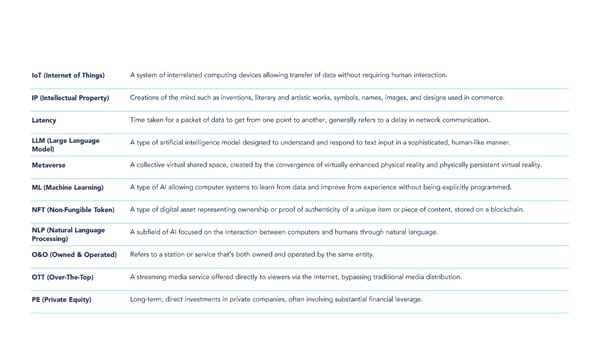
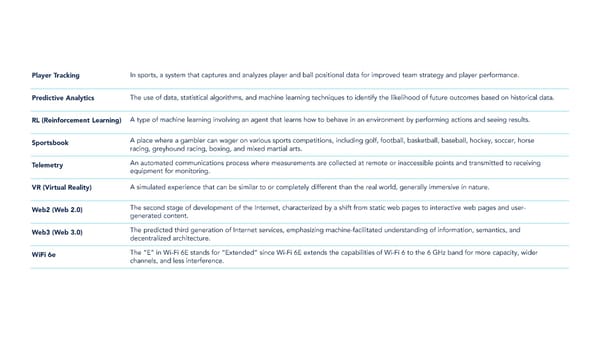
Powered by RELAYTO RELAYTO is the #1 Interactive Experience platform that transforms your static content (PDFs, MP4s, images) into engaging interactive experiences, enabling viewers to choose their own path and self-educate. RELAYTO IS THE NUMBER Simply import your PDFs and presentations (and add any supporting content, ONE INTERACTIVE text, web/social content, images, video, and audio) into our intuitive builder to assign interactive elements and publish to your team for instant viewing on EXPERIENCE PLATFORM desktop and mobile screens. THAT TRANSFORMS With RELAYTO, you can create an unlimited number of public and private STATIC CONTENT INTO interactive experiences equipped with security, permissions and user management to control who has access to your content. Metrics deliver ENGAGING INTERACTIVE insights on 360 digital body language, activity and intent, summarizing when & EXPERIENCES where viewers spent their time, so you can prioritize your outreach efforts... and keep improving your content. From e-books and white papers to pitches and proposals RELAYTO is the simplest way to make your existing content captivating and insightful.
Executive Summary As the sports technology market grows in influence and maturity, the terms that bounce around more established tech sectors become relevant. One, in particular, is that of "prophets" and "wizards". TEAM WIZARD "Wizards" refer to experts thoroughly versed in capabilities of tech-led OR TEAM PROPHET? innovation. They enable the rest of us to navigate our respective landscapes using current, relevant tech, conjuring up code and widgets into solutions the rest of us consequently take in our stride. "Prophets", on the other hand, are the visionaries who anticipate the future. While they may not be able to alchemize in the manner of wizards, they lead thinking and guide sport towards new digital trends. What are these? It is impossible to ignore AI, which is impacting sports as much as every other aspect of life. In its summary of US market trends, Sports Tech HQ – the body responsible for Indiana’s vibrant sports tech ecosystem - describes it as ‘the single biggest innovation during this generation’. Similarly, award winning architects, HOK, looks at how AI is revolutionizing live sports and entertainment. This chapter considers the issue of ‘deep fake’ and authenticity in the realm of live sports, as well as the opportunity to attend events virtually or experience entertainment very differently; just think what the ABBA Voyage virtual concert model could achieve in sport. Both HOK and the DP World Tour celebrate live sports in their chapters and, whether you were supporting Europe or the US, the spectacle of The 2023 Ryder Cup was one of the year’s sporting highlights. The DP World Tour have written an indepth case study on exactly how they brought the event to life.
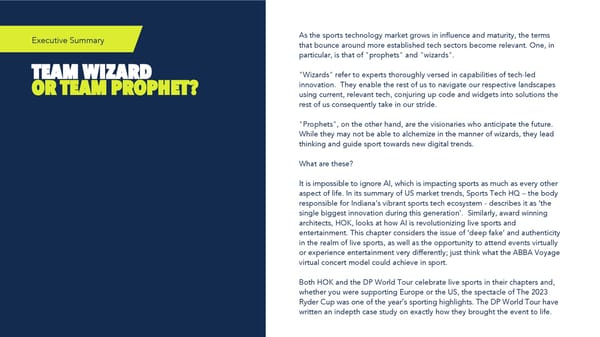
This is a modal window.
When you start to look at the event as 18 mini fields of play, as well as one Sportradar explores data in the era of third-party cookies’ demise. This is massive venue, you start to appreciate the complexity of the task they a must-read for any brand which undertakes programmatic advertising faced. Given what they delivered, you have to believe they are working on or digital personalization. In the light of the EU’s GDPR and the US’ the next one already. CCPA, sports brands, rights-holders, and sponsors need technologies for precisely targeted strategies and personalized content. If you work If live sports are the Colosseum, then the athletes are the gladiators – and on the business side of sport and don’t know what a Data Clean Room what care we should take of them. With head injuries now such a pressing is, you probably should …and this chapter is an excellent guide. issue in many sports, Love of the Game, explores how med-tech is helping tackle brain trauma. It is shocking to read how extensively misunderstood In 2022 we bemoaned that tech-forward apparel was behind the curve basics elements of this space - such as concussion - are. Fortunately in influencing athletes’ performance; well, it has caught up! As the ‘super emerging technologies are refining injury identification and treatments. shoe’ scythes seconds off records, we take a historic look at ‘tech And, as they become more readily available. expectations on sports doping’ in sport and consider what those moments mean in future. At governing bodies to uphold this area of athlete safety will become what point will ‘marginal gains’ become all out ‘tech doping’? greater. The 2023 Sports Technology Annual Review is the result of some As we look to safeguard the physical well-being of our sportspeople, to outstanding input from wizards and prophets alike, sharing a what extent do we need to look after their digital rights? The subject of provocative and exciting view of the sports landscape today. Whichever data arises in three forms this year. Firstly, the topic of athlete data team you deem yourself to be part of – wizard or prophet - if your remit ownership is debated. In this chapter we explore the practical, financial is to help shape the future of your sport or brand, we hope The Review and moral considerations of individual versus organizational ownership – has equipped you with some fresh thinking. see which argument swings you. Secondly, Genius Sports explains how data’s significance in sports broadcasting has grown. Driven by AI and the ‘Moneyball revolution’, fans’ highly personalized demands are considered, from detailed team and player performance data, to a choice of camera angles. Consequently, broadcasters need to respond – but how? This chapter explains.
Love of the Game looks to unite the fields of sport, technology, science, academia and business to identify, invest and implement innovative solutions that will mitigate the health risks arising in so many sports, whether team or individual, contact or non-contact. Through our unique network of supporters representing the UK’s major sports, government, academic institutions and business, we seek to drive awareness and funding of the research A NEW GAMEPLAN and development of solutions to aid in the prevention, diagnosis, and treatment of head FOR SPORT-RELATED injuries, concussion and related problems. HEAD TRAUMA With our collective passion, goodwill and expertise, our aim is to reduce, manage or cure concussion related injuries, ensure the longevity of players’ games and careers, and safeguard the integrity of the sports we know and love. Love of the Game represents a meeting of minds from across sport, science, business, technology and government. With an open-source approach to information sharing and an unwavering focus on driving actionable solutions, the initiative will address the following pillars of engagement: Authored by • Education • Diagnosis • Treatment • Prevention
A NEW GAMEPLAN Elite riders, jockeys and cyclists understand the risks of falling, just as boxers and UFC fighters are prepared for the threat of head injury as part of their sports. Sadly, they are FOR SPORT-RELATED being joined by athletes in more sports – such as NFL, rugby, ice hockey, Australian Rules HEAD TRAUMA football and rugby league – but the issues are also highly prevalent for those in snow sports and, surprisingly, cheerleading. In the realm of high-performance athletics, Regardless of the discipline, head trauma poses a substantial issue with several grave recognizing and acknowledging risk is woven into repercussions, including loss of muscle strength, fine motor skills, speech, vision, hearing the fabric of participation. or taste, as well as long- or short-term changes in personality or behaviour, and depression. Within this challenging landscape, there is promising news; clinicians and medical technologists are improving methods of identifying type and extent of trauma as well as how to treat head injuries better. Technology is proving central to this. Arguably, the first step in improving this aspect of athlete welfare is to ensure better levels of understanding about the term 'concussion', which is misunderstood on two levels. • Firstly, it is a term liberally used but poorly understood. Concussion can be caused by whiplash, not simply a direct blow – in other words, it isn’t damaging the brain by hitting it directly, it is about causing the brain to hit or shear against the inside of the skull at speed. Consequently, you can be hit from behind and sustain damage to the front of the brain – this is called a contra-coup injury. And it doesn’t take much. A g- force of 90-to-100, equivalent to colliding with a wall at 20 mph, can cause enough whiplash to lead to a concussion. • Secondly, a common misconception about concussion is that brain injuries solely manifest with symptoms; they can also result in dysfunctional outcomes.
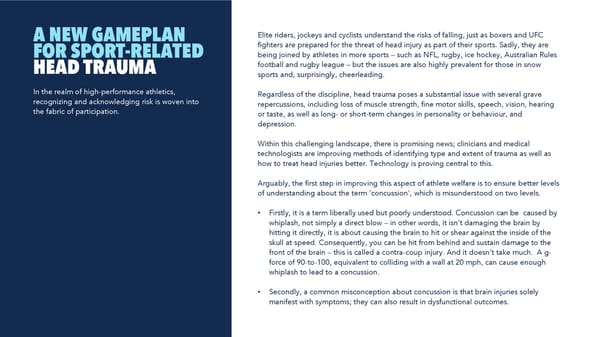
This is a modal window.
Athletes often respond to a preliminary head blow by clearly ‘seeming • PolarCap® is a portable cooling headcap that treats ‘concussed’ injured.’ However, this visible outward reaction does not accurately reflect athletes the inner damage sustained by the brain. This gives rise to the complexity of assessment, where the true extent of a brain injury often remains unclear We are at a point in professional sports where, for the first time, certain for at least 36-48 hours. The introduction of assessment protocols and player sporting disciplines are having to compete to attract athletes at rest directives is a good stride forward, but it fails at the ‘one size fits all’ grassroots, who, in turn, become the elite performers of tomorrow. For generalized approach that may not address individual differences. example, why let your child play football (NFL) or rugby when there is real and significant risk of head injury compared with golf, athletics or Accurate evaluation of an injury's extent is paramount; a three-week break is tennis? Additionally, the pressure of good stewardship on governing the minimum but should be coupled with active treatment. Asking someone bodies requires them to ‘do the right thing’ for their athletes. Injury to lie in a dark room for three weeks is as flawed as it is passive. avoidance and good treatment protocols are – and should be – central to their duty of care. The approach to brain injuries should echo that applied for other soft tissue injuries—emphasizing the avoidance of scarring as a crucial aspect. Cold In an ideal world, this would mean encouraging, facilitating or therapy, as used for torn muscles or sprains, is as necessary for treating underwriting brain scans for young sportspeople once their brain has brains which have been subject to trauma. Its central benefit is that it aids fully developed, usually in their early twenties. This would equip them the provision of blood and oxygen to the affected area. Brains, however, with a fundamental baseline by which their future brain health could be require something more subtle than an ice pack on the head; what is needed assessed. In turn, this could potentially predict and prevent – or at worst is slow-release cooling over an extended period. accurately identify - the extent of future injuries. Fortunately, a new era in treatment is dawning, with technologies available By holistically and critically addressing the issue of head trauma in that cater adeptly to the requirements that are now understood to be sports, the sports and medical communities have a crucial opportunity. needed. Here are a sample of those leading the field Pushing our knowledge of the brain, how it functions and how it heals • WAVIBrain Scanner is a platform that facilitates portable brain trauma ensures a safer sporting environment and a healthier future for our assessment athletes. Although we still have a long road ahead, the strides made so • NeuroFlex® is a platform which uses VR technology to track head and eye far are exciting and technologies are proving to be a massive element in movements. This can help to determine if a concussion has occurred. our progress.
The biennial Ryder Cup, founded in 1927, is golf’s greatest team contest and one of the landmark events in global sport. It sees the 24 leading golfers from the United States and Europe go head-to-head in a three-day gladiatorial battle. The 2023 match, held at Marco Simone Golf and Country Club, saw ticket applications from 140 different countries, with 272,000 spectators descending on Rome. Organized by Ryder Cup Europe - part of the European Tour group - the Tour’s vision was to match the gladiatorial contest inside the ropes, with a rich amphitheatre of technology to ROME match. While innovative technology and ancient history may not appear to go hand-in- 2023 hand, the fundamental expectation of the modern-day spectator is technology that is ubiquitous, frictionless and reliable. Golf is arguably the most technologically challenging sport in the industry. There is not one single stadium to connect, but 18 fields of play spread across many acres. For the Ryder Cup in Rome, a mini smart city was essentially built from scratch in the middle of the countryside. Furthermore, technology is more relevant in golf than many other sports because it can be challenging for spectators to understand the status of play across a vast competitive landscape. Our challenge was to bridge the gap between armchair fan and on-course Authored by spectator. The 2023 Ryder Cup proved to be one of the most intelligent sporting experiences ever, and contrary to the perception that Rome is paved in history, unequivocal innovation was brought to the eternal city.
The roll-out of this strategy was based on six core areas, with the help of technology ROME partners such as Capgemini, Hewlett Packard Enterprises and CDW, who helped shape a 2023 best-in-class technology experience. Great connectivity, enhanced navigation and interactive communications The technology strategy for the Ryder Cup was optimised the tournament experience, enabling fans to spend more time based on three Es – to create Engagement, watching golf, soaking up the atmosphere and immersing themselves in the Excitement and a lasting Experience. Engagement experience. New technology features included: through location-based services and targeting with relevant rich media content, generating excitement • 24 Large LED screens, with over 2,000m2 of LED (which was a 25% uplift on through the delivery of new course features that got Paris 2018), and over 500 Digital TVs. fans closer to the action, and ultimately ensuring • One of the first and the largest deployment of WiFi 6e for any major that it was one of the best sporting events they’ve sporting event – over 800 access points. ever experienced. • Launching Outcome IQ, developed by Capgemini, which gave constant updates on who is statistically likely to win each match and the overall competition. • A shot-by-shot tracker on the mobile app with multiple data points (distance, number of strokes, lie etc) providing near instantaneous updates. • Location-based insights to facilitate rich media push notifications telling people when a player is on a hot streak, or showing merchandise offers.
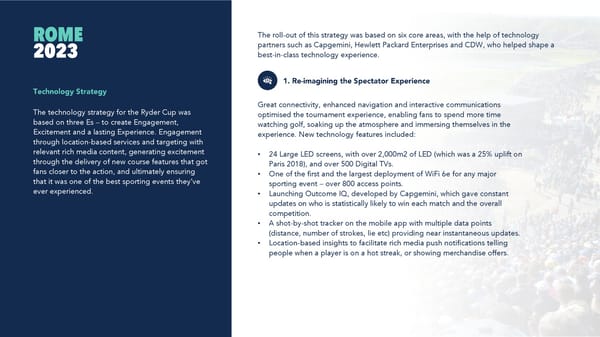
This is a modal window.
Technology partners ensured this Ryder Cup was the most data-driven The Ryder Cup leveraged a best of breed networking infrastructure with ever by implementing a visualisation platform, with multiple data sources, location-based services. This included Wi-Fi 6e (a first at a major sporting that meant fans and staff could make smarter real-time decisions. event) and a true environmental IoT platform (a first for golf). The Examples included: experience was highly secure and easier to get connected than ever before, • Using the player locator app, fans could see where each match was via using a complementary range of services from Wi-Fi, cellular, satellite, 5G a map and their latest scores. and LTE to optimise connectivity and deliver richer content on every • Spectator flows and interactions with food stalls, merchandise stores, device. Highlights included: and grandstand seating were visualised for both spectators and the • Three additional mobile masts for enhanced connectivity, two supplied staging teams via an app and graded display system. by national Italian operator TIM and one supplied by Vodafone. The HPE GreenLake edge-to-cloud platform, and Aruba network • Two Proof of Concept’s were delivered, one based on HPE’s Athonet connectivity, were at the core of this data-in and intelligence-out Private 5G network service and the other an innovative Solar-powered approach. Capgemini were instrumental in the programme management Wi-Fi and private 5G with direct internet connectivity. of the planning, preparations, deployment and service operations. • Satellite connectivity for areas where power was restricted, and Microwave point-to-point where ducting wasn’t possible. The infrastructure supported over 20,000 concurrent devices at its daily peak, and over 90 Terabytes of data across the week, one of the highest volumes of data for any single venue sporting event.
The event benefited from the first ever intelligence wall in sport for Ryder Cup Europe set out to make Rome the most sustainable Ryder managing tournament operations. This enabled proactive monitoring of Cup ever. On a technology level, innovations included: the technology across the course and ensured robust deployment. The Ryder Cup also used one of sport’s first ever pan-venue IOT based • 14 solar powered weather stations across all 18 holes, each edge-to-cloud computing platforms with a range of IoT environmental recording up to 12 measurements every three seconds. sensors deployed: • Through cloud-based technology and smart purchasing, avoiding single-use technology wherever possible. • x140 power sensors (LoRa) • Over 100 environment sensors for operational efficiency. • x5 multi sensors (temperature, humidity) • Infrastructure with smart power control, to ease the power-up of Wi- • x5 EnOcean USB dongles Fi in the mornings. • x5 contact sensors • Wireless technologies to reduce cabling. • x2 motion sensors • Sports first-ever “solar-powered” weather sensors for areas where • x2 water leak sensors power was restricted. • x2 smoke alarm sensors. • Over 50% of all buggies were recharged using solar-powered recharging stations This was all monitored by a new sustainability dashboard, measuring the carbon footprint of our IT infrastructure in real time and graphically reporting carbon impacts, power consumption and energy costs. The core emissions of the event were also offset, including all staging operations and player/staff travel. We also ran a campaign encouraging fans to offset their journey to Rome via the official Ryder Cup app.
A sporting event of this scale requires a robust operations structure to make sure any issues are dealt with at speed. An Olympic-type operational structure was deployed, establishing a front-line level I support with a call-handing facility for triaging calls coming through from Incident Control. For level II resolution, a Technology Operations Centre (TOC) was set-up with several technology suppliers represented and working across two daily shift-patterns. For level III support, which was predominantly remote, the relevant process and SLAs were set-up with essential support across the technology supplier landscape. Given the threat of cyber-attacks, a Security Operations Centre (SOC) was also established on-site, with a Cyber Incident Response Team on stand- by for immediate action if needed. The SOC monitored an average of 175 million firewall session log records per day and were able to actively block 143 malicious attempts from across the globe. This structure proved incredibly successful, with the number of troubleshooting tickets raised reduced from 84 in 2018 to just 40 in 2023.
HOK Sports + Entertainment practice is part of HOK, an award-winning, global design, architecture, engineering and planning firm, which has 1,600 people across a network of 23 offices on three continents. HOK Sports + Entertainment plans and designs world-class sports facilities, specializing in the design of arenas, stadiums, ballparks, training facilities and entertainment centres. The group plans and designs world-class sports complexes that are centrepieces of successful, vibrant entertainment districts, communities and campuses. Current and recent projects VIRTUAL include Newcastle Gateshead Quays in Gateshead, England; FC Barcelona’s New Palau FRONT ROW Blaugrana in Barcelona, Spain; Valencia Arena in Valencia, Spain; the PHX Arena modernization in Phoenix, Arizona; Mercedes-Benz Stadium and the State Farm Arena renovation in Atlanta; new Major League Soccer stadiums in Miami and St. Louis; Rogers Place and the Ice District in Edmonton, Alberta; Little Caesars Arena in Detroit; and the renovation of Hard Rock Stadium in Miami. HOK designs buildings and spaces that respond to the needs of people and the environment. HOK designers are rooted in technical excellence, driven by imagination and focused on a solitary goal: to deliver solutions that inspire clients and communities. Authored by Case Studies
Welcome to the exciting future of AI-enhanced live events. From virtual reality (VR) to AI’S ROLE IN THE personalised highlights reels, artificial intelligence is reshaping how we experience sports EVOLUTION OF matches, concerts and more. LIVE SPORT AND The global live sports and entertainment market remains resilient, even amid uncertain ENTERTAINMENT economic times. Consumers consistently show a willingness to pay premium prices for live games and concerts. Despite all the technologies that virtualise, enhance and customise these events, the physical venue remains their beating heart. The lights dim as Beyoncé appears on stage, glittering in a sequined leotard. As she launches into "Crazy in Love," you feel the reverberations in VR and augmented reality (AR) can make you feel like you’re sitting on the centre line or your chest through the roar of the crowd. But you're front row while still in the comfort of home. The Premier League offers to give not actually in Atlanta’s Mercedes-Benz Stadium. remote fans an immersive matchday experience. Spectators use VR headsets or Instead, you're immersed in a hyper-realistic smartphones to chat with their friends while watching live matches from different angles concert simulation created by AI. With personalised and perspectives. Meanwhile, AR can overlay digital information and graphics to augment camera angles and a queued playlist, it's a bespoke in-stadium views. AR can be used to display player stats, trivia questions, or social media concert delivered straight to your living room. feeds. IBM and Wimbledon are using AI to transform the digital Wimbledon experience. For 2023, they used their to develop an AI commentary feature that provides automated match narration for highlight videos on the Wimbledon website and app. The system uses a generative language model fine-tuned with the use of unique Wimbledon nomenclature. This technology could eventually offer every fan their own tailor-made sports or music event recaps.
The Swedish pop group ABBA is achieving huge success with ABBA This means that live and authentic events will become much more Voyage, a virtual concert residency in London. The performance features sought-after. digital avatars of long-retired band members playing hits like “Waterloo” and “Dancing Queen.” Using motion capture technology and visual effects, the show allows the band to virtually perform as holograms without being physically present in the custom-designed, demountable, 3,000-capacity arena. Since opening in 2022, this AI- On the plus side, sports teams are leveraging AI and machine learning enhanced show has for many different uses. These range from enhancing the fan experience to offering game insights and bringing in talent. But the usefulness of While impressive, can manufactured content replace the appeal of live data-driven technology doesn't stop there. Predictive analytics and music? What happens to the experience when all the imperfections of optimization techniques offer another layer of sophistication. Event living, breathing people are engineered out? organizers can use these advanced tools for planning, scheduling, and management of live events. Data for these analytics comes from a myriad of sources. Ticket sales, social media engagement, weather forecasts, and traffic patterns all feed With the rise of powerful AI image, video and music generators that are the algorithms. The goal is to proactively identify and adapt to variables freely accessible to anyone with an Internet connection, we face an that could impact the success of live events. By doing so, these tools existential crisis of authenticity. boost operational efficiency and profitability. Most importantly, they contribute to a better overall experience for fans. Fake content will soon flood social media platforms like TikTok, Instagram and YouTube, placing authenticity in the digital realm under siege. Generative AI can craft photorealistic media and music that few can distinguish from the real thing. Social media has already distorted reality through selective editing and filters, which has become the norm on our Architects and designers are using AI to help create deeply immersive feeds. As AI capabilities become more sophisticated, determining what is experiences. As this ultimately becomes the norm, how do we preserve real versus fake online will become increasingly challenging. the distinct collective energy that draws us like magnets to live events?
The sweet smell of stadium grass, the palpable energy in the air, the sounds of people chanting and singing—these idiosyncrasies help make each event memorable. While AI can personalise content, it can’t duplicate the near-transcendent feeling created when people gather in a shared space. Despite the allure of digital stadiums crafted by metaverse architects, the physical arena will remain the epicentre of live events. The pandemic seemed to confirm this, with live events making a resounding comeback as soon as restrictions were lifted. Digital platforms offer intriguing possibilities for fans who are unable to attend live events. But they will never be a replacement for the real thing. Hybrid events that combine in-person and virtual experiences are emerging as a compromise. They expand accessibility while preserving the essence of live participation. For us, the solution is to thoughtfully blend AI-powered and other technological innovations while keeping the focus on the action inside a stadium or arena. Venues should remain a blank canvas that should be easily adapted and personalised to differing uses and formats. While VR and AR can supplement that in-venue experience, they can’t replicate the collective energy of thousands of people gathered to experience an event together. If integrated with care, however, AI’s emerging abilities to enhance live events can help preserve that magic.
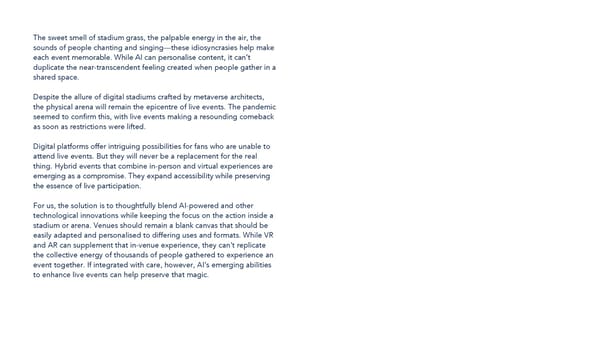
This is a modal window.
Genius Sports is the official data, technology and broadcast partner that powers the global ecosystem connecting sports, betting and media. The company’s technology is used in over 150 countries worldwide, creating highly immersive products that enrich fan experiences for the entire sports industry. As the trusted partner to over 400 sports organisations, Genius Sports works closely with many of the world’s largest leagues and federations such as the NFL, EPL, FIBA, NCAA, DATA-DRIVEN World Rugby, ECB and European Tour. SPORTS Genius Sports is also powering a new wave of augmented broadcasts on top-tier competitions including the NFL and EPL. By combining rich tracking data with unique BROADCASTS computer vision and machine learning capabilities, Genius Sports powers data-driven graphics, overlays and visualisations in real-time, creating highly immersive viewing experiences. Genius Sports works in partnership with CBS, NFL+, TSN, ESPN, Premier League Productions and more. Authored by
DATA-DRIVEN More than ever before, data and stats play a central role in the fan experience. Today fans, both young and old, don’t just want to know the basics such as the final score and the man of SPORTS the match. Instead, they want detailed team and player performance data such as expected BROADCASTS goals (xG) or the number of team presses, creating a completely new language amongst analytical fans. The soaring value of sports data seems to be Inevitably broadcasts, as the centrepiece of a multibillion pound industry, reflect the growing unassailable. Accelerated by the Moneyball fan demand for stats and insights. Whilst the box score is virtually synonymous with every revolution and more recently the incredible major basketball broadcast other sports such as rugby in the Six Nations built lengthy capabilities of artificial intelligence (AI), data is partnerships with Amazon Web Services (AWS) and other sports analytics providers to deliver critical to how modern sports are played, match insights such as kick success rates and player tackle counts. consumed, analysed, and monetised. However, where once fans experienced delays in how and when statistics were viewed, now a new innovation wave is transforming the live broadcast experience with stats overlays and visualisations delivered in real-time to unlock a wealth of new engagement and monetisation opportunities. According to Deloitte’s recent ‘immersive Sports Fandom’ report, 46% of Gen Z fans expect real-time stats and analysis to form a central part of their live sports broadcast experience. Broadcasters and streaming giants now recognise that a generation of fans who have grown up playing Madden, FIFA or similar games, expect an increasingly gamified and data-driven viewing experience. And with advancements in optical tracking technology and computer vision capabilities, broadcasters are now able to provide split-second game insights to millions of viewers.
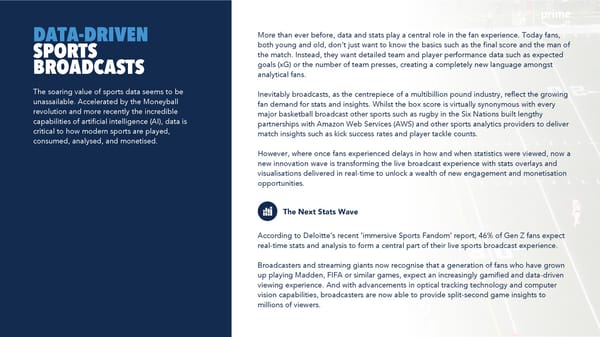
This is a modal window.
This generational shift in fan engagement is embodied by the Sports Emmy-winning Amazon Prime Vision with Next Gen Stats. As a data- driven alternate broadcast of the NFL on Prime Video’s Thursday Night Football, Prime Vision provides viewers with a wealth of granular game For now, data-themed broadcasts are primarily offered as an alternate insights such as player running speeds, quarterback time in the pocket, viewing mode, separate from the traditional programme. But as demand running yards, passing yardage and more. for these immersive broadcasts grows, it is inevitable that these data- Now in its second season, Prime Vision not only helps fans understand driven features will become more mainstream. Detailed insights such as what is happening in real-time, but it also allows them to predict what is player names above their heads or pitch maps that show the location of about to happen on the next play. New AI and computer vision each player and the ball, will rapidly become the new normal. capabilities have enabled Amazon Prime Vision to deliver ground- breaking new features including Prime Targets to show which receivers The challenge for broadcasters and major streaming companies will be to are open for the quarterback to pass to. Similarly, Defensive Alerts fine tune the roll out that appeals to this emerging demographic. After all, shows fans which players are about to rush the quarterback, creating an different generations demand different things from their live sports immersive viewing experience driven by data. broadcasts. Deloitte’s study found only 23% of Boomers wanted stats and analysis to be integrated into their live experience. The Premier League Data Zone is also breaking new ground in providing fans with data-driven broadcasts in real-time. Available to all While viewing consumption behaviour is changing, broadcasters must international broadcasters of the Premier League, Data Zone deploys a remain sensitive to different generational demands when introducing new unique L-bar format to provide viewers with constant metrics and updates including player names, shot speeds, distances travelled, innovations. For example, Sky Sports’ Monday Night Football has recently passing accuracy and more. To further engage fans through data, the started using skeletal tracking data and 3D renders to show viewers Data Zone also showcases official updates and points from Fantasy exactly what a player would see before making a crucial pass or shot. For Premier League which has over 11 million players worldwide. some viewers, this provides really fascinating in-depth player insights about the game but to others, it may be seen as an unnecessary distraction from what they normally watch.
The new reality is that data rich alternate streams are just the start of a new wave of personalisation that is sweeping across the broadcasting world. For decades, broadcasting in general has operated on a one to manymodel with viewers receiving the same homogenised product. However, as other industries are being swept up in a wave of personalisation, the sports industry must adapt rapidly to this new commercial reality to thrive. With broadcasters and streaming platforms now able to display content in real-time, we’ve reached a tipping point where fans are already the curators of their own content. This new era of curated content will heighten demand for personalisation and in the future, the viewer will become the director. Fans will be able to customise the experience they receive including the camera angles they watch through as well as whether stats, fantasy points, betting odds, merchandise promotions and more will be integrated directly into what they’re watching. The revolution will not be televised, it will be personalised.
This chapter has been drafted following The STA Group’s Great Debate event in September. 150 people from all walks of sport gathered to hear four industry experts discuss the topic of athlete data ownership. Former Olympic sprinter, turned sports entrepreneur, Andrew Steele and Tim Lopez, Director CSM Talent, argued for athletes to control their own data, while lawyer, Andy THE DEBATE OF Danson, Bird and Bird and Paul McKernan, CEO, STATSports argued that this data should ATHLETE DATA belong to the organizations which collect it. OWNERSHIP What was the result? A draw. What was apparent is that some sports and competitions – most notably tennis and cricket – have seized the initiative in this space while some other federations will soon find themselves playing catch up.
THE DEBATE OF On the one hand, proponents of organizational control argue the justice of such a stance stems from practicality and fairness. The collecting bodies, often sport franchises or clubs, ATHLETE DATA are, in essence, the employers of athletes. This employer status identifies them as the OWNERSHIP appropriate owners of the data, enabling them to deliver optimized coaching and improving overall stakeholder experience. Emerging as an indispensable element of elite Financially, the collection and analysis of this data do not come devoid of considerable sports, data and technical analysis equip teams and investment, which is justified by generated income from commercial deals. Athletes, being athletes with an edge that significantly impacts their financially compensated from this income, are theorized to have then surrendered the performance. Not only does this transformation commercial rights to their performance data. render the competitive field more thrilling for fans, it also elevates engagement levels to Furthermore, legal codes ensure the protection of athletes when it comes to data. unprecedented highs. Intellectual property laws shield the collecting bodies’ rights and interests, balanced by data protection and privacy standards safeguarding the individuals’ rights. Importantly, Central to this equation is the ownership of the athletes have legal authority over who processes their personal data. collected data, which poses ethical, economic, legal and practical considerations. Should athlete data Nonetheless, it is crucial to distinguish between athletes' protection under data privacy remain the property of the organizations compiling regulations and ownership of commercial rights. The latter is critical for the independent it or should it belong to the athletes themselves? functioning of the sports economy. Finally, from a practical viewpoint, how can a manager organize team performance effectively without full access to all players’ data aggregated on one platform?

This is a modal window.
However, the opposing viewpoint advocates athlete-controlled data. Fundamentally, the crux of this argument lies within the belief in 'athlete ownership of athlete data.' With recognition and adoption of this principle, advocates propose the cultivation of an equal-benefits infrastructure. This collaborative approach within a regulated framework aims to enhance quality and stimulate growth potential for all stakeholders. Undoubtedly some athletes might withhold their data, but with appropriate incentives and frameworks, the majority are projected to embrace their personal and financial development possibilities. Beyond legal obligations, the discussion brings the moral concern into focus. Is it ethically acceptable to prohibit athletes from controlling and benefitting from their own data when other stakeholders are already reaping financial and other benefits? In conclusion, the question of athlete data ownership is far from a straightforward issue. Balancing practical, ethical, and legal implications present a complex challenge. It calls for a careful and inclusive dialogue across all parties to determine the most equitable solution that supports athletes, sport organizations, and the industry at large. While technological advancements have indeed revolutionized elite sports, it is incumbent upon stakeholders to ensure that this revolution evolves in a manner that respects and protects all stakeholders involved.
Sports Tech HQ (STHQ) is responsible for building a vibrant sports tech ecosystem in Indiana. The foundational sports and sports innovation roots are deep in this central US State. These major sports organizations call Indiana home: USA Track & Field, USA Gymnastics, USA Football, National Collegiate Athletic Association (NCAA), National Federation of State High School Associations (NFHS) and the American College of Sports Medicine (ACSM). Known as the motorsports capital of the world, the Indianapolis Motor Speedway is the largest sports venue in the world. Each year over 400,000 people attend TECH-LED SPORTS the largest single day sporting event in the world (Indianapolis 500). The nation’s first sports commission, Indiana Sports Corp, has procured major events such as: Men’s NCAA Final INNOVATION Four (8x), Women’s NCAA Final Four (3x), Super Bowl, College Football National Championship Game, NBA All-Star Game (x2), Pan Am Games, World Gymnastics Championships, World Basketball Championships, World Swimming Championships, US Olympic Team Trials (x19), and many more. With two major sports league teams (Indiana Pacers – NBA & Indianapolis Colts – NFL) and a bevy of minor league teams, professional sports are prominent. Sports Tech HQ cultivates, grows, and accelerates the sports technology ecosystem in Indiana. With a friendly business environment, attractive cost of living, incredible talent Authored by pipelines at top universities, and the rich sports economy, all the ingredients are ripe for sports technology attraction and growth.
THE VIEW We are excited to see how youth sports opportunities continue to drive value farther down the development of the next generation of athletes. Professional FROM HQ athletes and the elite amateur athletes have access to the latest and greatest technologies. Youth sports is incredibly fruitful and let’s face it, all parents at some point or another have likely pondered the likelihood of their little athlete one day making it to the big leagues. Hope and optimism are the motivators for parents to invest heavily into the growth and There are many indicators in the US for the future of development of their offspring. In the United States in particular, the wave of Name Image our industry. The proliferation of AI seems to and Likeness (NIL) being widely adopted across colleges and universities is pushing up the dominate the airwaves now and we see that timelines for the money-making athlete. The prioritization of health, wellness, and injury powerful technology continuing to evolve at a prevention is a trend we will see starting to flow downstream from the professional ranks to breakneck pace. It might go down as the single youth. The market for youth sports is substantial and often overlooked. In the US alone, biggest innovation during this generation. There families spend $30-$40 billion annually on their children’s sports activities. Companies that are plenty of other opportunities for founders and can figure out how to navigate the complexity of youth sports organizations and rights entrepreneurs outside of AI. We break down the holders might find tremendous opportunity. different sectors within the sports tech industry into Watchlist: is democratizing advanced analytics for basketball players with three main pillars: For Athletes, For Fans, For “chip in ball” technology. is solving the common problem of ankle injuries. Executives. Without fans, we don’t have professional sports. Period. Fans…short for fanatics can be just that. We live in a world where the ultimate weapon of mass distraction (smartphone) is at the fingertips of billions of people equating to 85% of the global population. Teams, leagues, and governing bodies have to find a profitable balance of delivering an excellent in-person experience and a complementary in-home experience. Just as those billions of people have a choice of what app to engage with or how many hours they scroll per day, we feel the people will decide how they want the content served up to them. Personalized sports content is the ultimate end. The fans decide how they want to consume their sport of choice. Perhaps it is in an arena and they want to follow audio for their favourite player.
Or maybe at home, they can choose the camera built into the helmet of their couch and consume the game in person. The personalized fan their chosen athlete. They can watch the entire game from that experience is how teams will attract fans to their arena seats vs. their perspective. And it doesn’t stop with professional sports. Youth sports couch. Imagine being able to turn that arena or stadium seat into a productions will look more like the professional sports that we know personalized immersive experience of the game where the fan can today. AI broadcasts with AI generative graphics and AI announcers are choose what they hear and feel. Or imagine bringing the stadium all in the works. Soon grandparents, parents, extended family, and experience to a neighbourhood near you. friends will be able to watch little Johnny or Julie just like they consume Watchlist: is creating a refreshed in arena their professional sports today. Professional sports may end up immersive experience in the comfort of your seat. is a highly becoming much more intimate with behind-the-scenes content – i.e. immersive venue experience with content partnerships looking to Drive to Survive, Full Swing, Hard Knocks, etc. Content is and remains expand to 20+ markets on the US. is a generative AI king. We see companies beginning to realize the large-scale content tool that has entered sports via auto-racing. opportunities in amateur sports. Watchlist: is solving the problem of making live sports Sources: a reality at all levels of the game utilizing AI broadcast utilities. Project Play is an OTT product that white labels streaming platforms so companies can scale quickly. Exploding Topics Billion-dollar multimedia rights, multi-million dollar player contracts, college athletes earning income from their name, image, and likeness. What has happened to sports? Decisions are made with a plethora of data tied to team and player performance and the fan experience. Is there a better example of a movie that has influenced sports as we know today than Moneyball? The stakes are high and the win at all cost mantra is on full display. Quantum computing and generative AI tied will allow data driven decisions to made in real-time. The most common trend we hear is tied to the frictionless fan experience. Teams and leagues are looking for solutions to pry fans off
Sportradar, the leading global sports technology company creating immersive experiences for sports fans and bettors. Established in 2001, the company is well-positioned at the intersection of the sports, media and betting industries, providing sports federations, news media, consumer platforms and sports betting operators with a range of solutions to help grow their business. IN A NEW ERA OF Sportradar employs more than 2,300 full time employees across 19 countries around the PRIVACY AND FIRST world. It is our commitment to excellent service, quality and reliability that makes us the trusted partner of more than 1,600 customers in over 120 countries and an official partner of PARTY DATA the NBA, NHL, MLB, NASCAR, FIFA, UEFA, ICC and ITF. We cover more than 750,000 events annually across 83 sports. With deep industry relationships, Sportradar is not just redefining the sports fan experience; it also safeguards the sports themselves through its Integrity Services division and advocacy for an integrity-driven environment for all involved. Authored by
IN A NEW ERA OF Providing a deep understanding of user behaviour, these tiny third-party data trackers have been the lifeblood of personalised advertising, allowing companies to craft highly targeted PRIVACY AND FIRST programmatic advertising campaigns based on their users’ browsing history. Since the mid- PARTY DATA 1990s cookies have been the digital backbone of engagement, acquisition and retention, and revenue generation. The impending demise of third-party cookies has However, the status quo is changing, and Google's announcement to phase out third-party sent significant ripples across various industries, cookies, following in the wake of Firefox and Safari, is creating a new challenge for sports- including the sports sector. For some, this is related industries. This is most notably relevant for those relying on programmatic triggering feelings of anxiety. Instead, it should be advertising and digital personalisation to target products and services, such as event viewed as an opportunity to embrace new tickets, betting odds and media subscriptions. Also, for sponsors, in relation to how they technologies designed to deliver enhanced can continue to extract requisite value from their quite often significant sports rights engagement with fans, while smoothing the way investments. into the new era. Today, rightsholders and sports brands find themselves at a critical juncture and are already taking action. They are exploring new technologies that can facilitate the continuation of precise fan targeting strategies, personalised content and accurately measuring performance. This is against a policy backdrop of privacy regulations, such as the EU’s GDPR and ePrivacy directive and the US’s CCPA. As the landscape shifts, sports fans continue to expect the same hyper-personalised content experiences they are now used to on other digital media services that seamlessly align with their interests and preferences. Innovative solutions capable of delivering actionable insights around fan behaviour and intent must be developed in order to continue to offer tangible return for all.
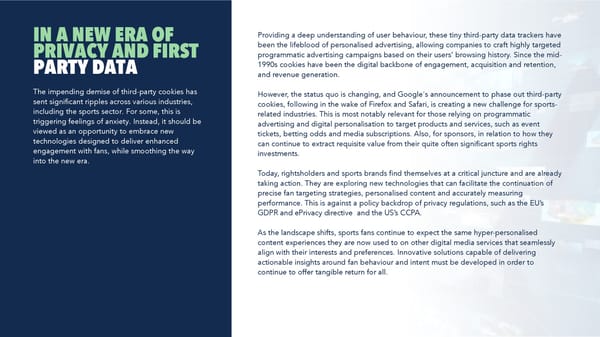
This is a modal window.
Contextual advertising is returning in importance as a marketing method Sportradar’s 20-year experience of providing scaled data and technology because it has the power to match messages with the sports-related capabilities to the various constituencies within the sports eco-system, digital content fans are enjoying. combined with our agnostic one-to-many philosophy, makes us well positioned to invest in the innovation required to support this progression However, to enable greater accuracy and personalisation, the industry is toward first party fan data collaboration. We have developed the first becoming more focused on building strategies to capture and connect sports industry-specific Data Clean Room, and combined it with our first party data. This identity data is collected directly and consensually sports-specific marketing activation platform – ad:s. from fans, delivering far greater accuracy and reliability than third-party data. This next generation sports Data Clean Room technology will power much more effective collaboration of anonymised first party data between As such, a development making significant impact is the evolution of Data sports federations, leagues, teams, media companies and sponsors, for Clean Rooms. These are secure environments facilitating data the benefit of all participants – and at the same time, the fan experience. collaboration between willing participants, including rights-holders, brands and media-owners. This enables the anonymised and compliant Data Clean Rooms delivers secure, centralised repository for all sharing of first party data to create far richer, multi-dimensional profiles of participants to access, creating much deeper insights around fan fans around their priority interests and inclinations. preference and intent. As an example, it enables the creation of very precise, high-intent segments for sponsors to target, while fully Not all Data Clean Rooms are the same however, as they can differ in safeguarding fan privacy. structure, privacy, flexibility and the ability to scale as required. The best versions utilise the latest ‘confidential computing’ cloud technology to For the rights-holder, Data Clean Rooms brings much-needed order and ensure that no data can be compromised, while offering the flexibility and control to cross-partner data utilisation, allowing them to more effectively scalability for collaborations between multiple partners. manage multiple partner and sponsor access demands, while protecting fans from a negative experience as a result of over messaging.
Importantly, each Clean Room participant is able to stipulate their own opportunities for any company interested in reaching sports fans. Data ‘rules of engagement’ related to their own data, sharing only as much as Clean Rooms, when combined with an advanced activation platform, they choose and in full control of how it is utilised. connect with the entire sports ecosystem – in effect, any brand wanting to connect with sports interested consumers. In these exciting times of innovation, the sports industry must be prepared to adapt and readily accept new technological innovations as they come online. In this way, not only will their journey be smoother, In Sportradar’s case, data in its Data Clean Room is fully unlocked via our but they will reap far richer rewards. proprietary activation technology – a sports specific digital marketing platform – where not only is all of the machine intelligence dedicated solely to sports fans, but where the inventory supply in a wide range of ‘Cookies, the GDPR, and the ePrivacy Directive (GDPR.EU, 2023): digital programmatic channels has been ‘curated’ with the same fans in mind, too. Combined platforms have the power to improve marketing practice for any company or brand interested in reaching sports fans. Data Clean Rooms, when combined with an advanced activation platform, can connect the eco-system around specific sports, with the rights-holder (Federation, League or team), as the ultimate and rightful ‘conductor’ of the fan experience, right at the centre. Collaboration between the wider sector, including commercial sponsors from other industries, unlocks valuable insights and broadens marketing
TECH DOPING V MARGINAL GAINS
TECH DOPING Major sports equipment and apparel brands have been pioneers in creating sporting gear with advanced design and innate technology. While such innovations undeniably maximize V MARGINAL GAINS the potential of athletes, the pertinent question remains: when do we cross the line, and how should such technologically forward sports gear be regulated? One striking and current example of such a technological intervention is the introduction of In sports, the pursuit of excellence is ceaseless, the Nike Vaporfly running ‘super shoes’. These shoes, designed with ZoomX foam and a pushing the limits of human performance. However, carbon fibre plate, along with vapor-weave (transparent, lightweight, and breathable) as technology evolves, facilitating ever-better material have revolutionized marathon running. According to a study published by the sports execution, those who control sports face an New York Times, runners wearing Vaporflys had a 4-5% advantage in race times over those increasingly tougher challenge as the distinction using other footwear. Arguably, the exceptional performance of athletes, such as Eliud between 'marginal gains' achieved through Kipchoge who shattered the 2-hour marathon barrier, has been substantially aided by technology become all-out 'tech doping'. What is Vaporflys, Adidas’ Adizero Pro, ASICS’ MetaRacer, Carbon X from HOKA and Saucony’s the future of competition if reliance on technology Endorphin Pro. World Athletics has been pragmatic; it states that super-shoes should be for performance enhancement goes too far? available to all athletes, negating any advantage through exclusive access. Looking historically, many sports have had ‘tech dope moments’ where a call has been needed. In tennis, Babolat Play, the world’s first connected racquet, has a built-in sensor tracks performance data, providing insights into the player’s game. It measures power, impact location, spin, and total playtime. While it unquestionably aids in training, when used in a professional match, it could give an unfair advantage by analysing the opponent’s play. The International Tennis Federation (ITF) responded to these concerns by permitting sensors only during the warm-up and practice, not allowing them in actual matches. The Wilson Clash, which uses carbon mapping technology to provide control and stability may not raise the issue of tech-doping but could conceivably raise questions pertaining to an athlete's skill versus the calibre of kit used.
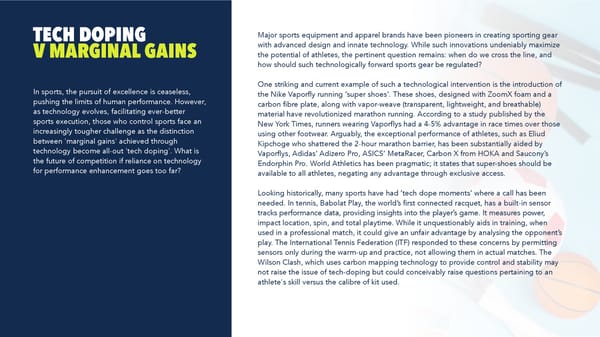
This is a modal window.
Ricky Ponting's Kookaburra bat, which had graphite reinforcements, bottle, is sports’ natural future not ‘mano a mano’ but man+machine? challenged cricket. This was hailed as the most potent bat ever used. Consign current records to history and start again? The International Cricket Council, very reasonably, determined that this Sports governing bodies face the onerous ongoing task of striking a balance gave batsmen unfair balance in a match so banned non-wooden between embracing progress while ensuring fair competition. Technological materials in bats. developments in sports offer athletes opportunities to push the boundaries The LZR Racer swimsuit by Speedo, launched in 2008. At the Beijing of human performance but the spirit of sports needs respecting, i.e. the Olympics that year, swimmers wearing the suit scooped a staggering celebration of hard work, talent, resilience, and competitive equity. The 94% of all swimming gold medals and set 33 new world records. Its question is, at what point does tech-led innovation intervene or enhance. dominance prompted the International Swimming Federation (FINA) to This topic will be debated as part of The STA Group Great Debate Lunch ban all body-length swimsuits in 2010, deciding that technology should Series at the Kia Oval on February 29 2024. not overshadow athletes' ability There are others examples across sport but a more nuanced issue is that If you are interested in attending the lunch. Please register your interest of para-athletes using running blades. Regulating them presents a unique challenge as technologies enabling disabled athletes to compete often straddle the line between necessity and advantage but they are not without controversy. Their curved design provides more significant energy return, enabling athletes to reach speeds close to, or in some cases superior to, their non-disabled counterparts. While tech-doping is not directly relevant in motorsports per se, the hot ‘drinking debate’ topic is how well the car, boat or bike serves the driver, pilot or rider – put them on another vehicle and would they do as well? Sports, ultimately, should essentially be contests of skill, strategy, training, and human spirit, facilitated - not replaced by technology… or should it? Is there an argument that since the genie is now out of the
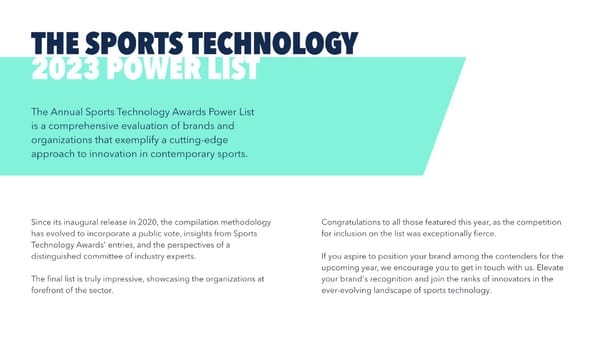
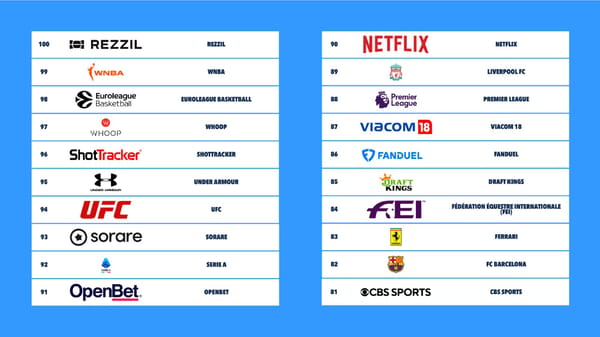
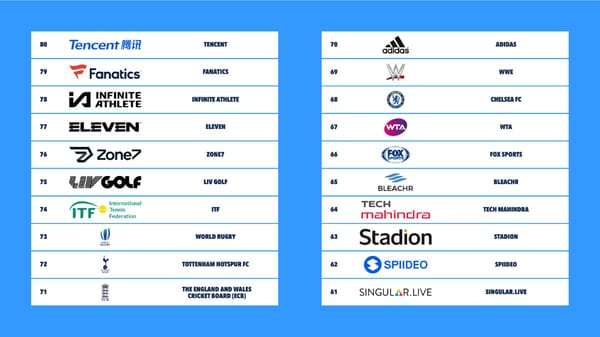
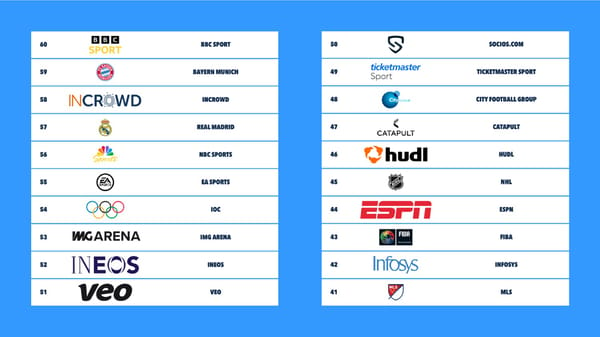
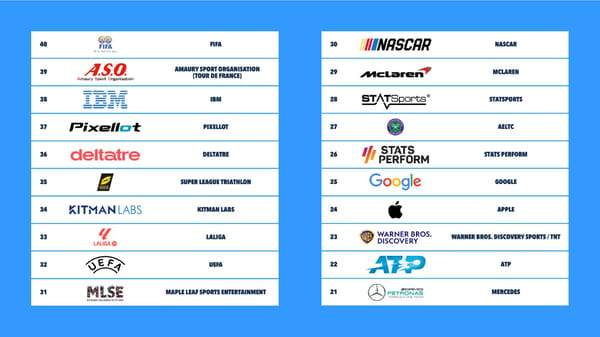
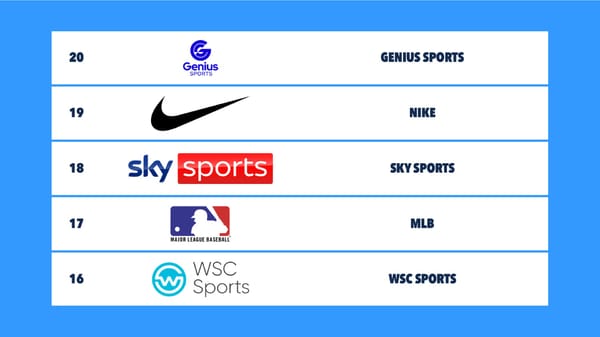
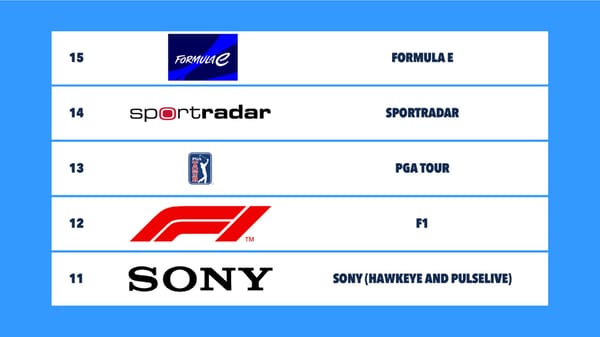
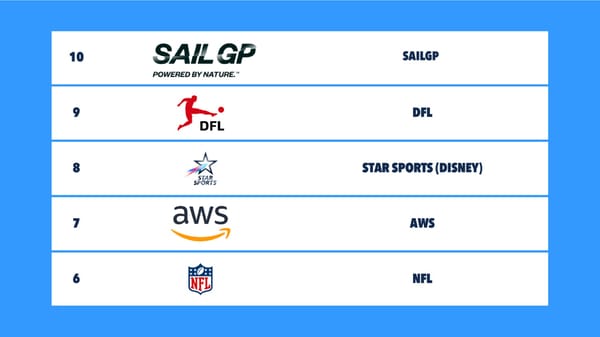
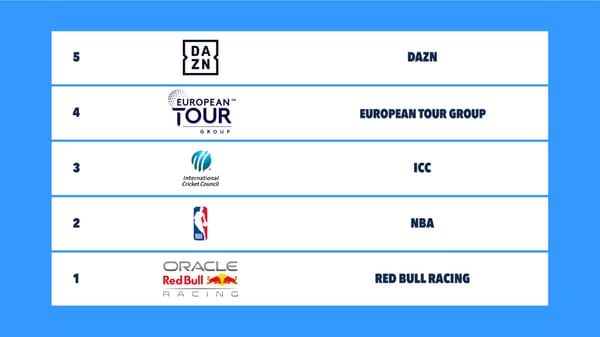
BRANDS SHAPING THE SECTOR
aiScout, Arccos Golf, Cleeng, ClubSpark, Coursetrack, Deltatre, DRIVE Hockey Analytics, Bleachr, Electronic Arts (EA), Eleven Sports Media, Dorna Sports, Fanbase, FanDuel, GameOn Extreme Networks, Genius Sports, Goodform, Hawk-Eye Innovations, Hudl, IBM, IMG Arena, Technology, InCrowd, Kiswe, Monterosa, Other Media, PT Sportsuite, Sport Buff, Sponix, Infosys, LA Clippers, Meshh, Metrica Sports, Nielsen Sports, Noah Basketball, NTT Data Oracle, Sportradar, Tech Mahindra, TikTok, Wit Sports Spiideo, SoFi Stadium, Sportlogiq, Sportradar, STATSports, TRACAB, Veo Technologies, Videocites, Yinzcam Apple, Athlete Monitoring, BatFast, ClassPass, Contego Sports, UK Sports Institute, Fitbit, Good Boost, HP 1T IMPACT Gumshields, LID, Love of the Game, NuroKor, Peloton, Sports & Apple TV+, At&T, AWS, BBC Sport, beIN MEDIA GROUP, CBS Sports, DAZN, DFL, Deltatre, Wellbeing Analytics, STATSports, Vitality Direct TV, Disguise, ELEVEN, Endeavor Streaming, ESPN, EVS Broadcast Equipment, FOX Sports, Grabyo, Gravity Media, Hawk-Eye Innovations, IMG, Intertrust Expressplay, Joymo, LiveU, MOOV, NBC Sports, Pixellot, Quidich Innovation Labs, Singular.live, Sky Sports, Star Sports India, Stats Perform, StreamAMG, Sunset+Vine, Supponor, TeraVolt, TNT Sports, DAIMANI, Invisionary Holdings, Mashgin, Melbourne Cricket Ground, Mercedes-Benz UniqFEED, Verimatrix, VITEC, Warner Bros. Discovery Sports, ViewLift, WSC Sports. Stadium, MuchBetter, OnePlan, San Francisco 49ers, STH Group, Snackr, Sodexo, SwipeStation, Tappit, Ticketmaster Sport, TiqAssist, Tixserve, The Cleveland Browns, Wicket Software aiScout, American College of Sports Medicine (ACSM), Betterguards Technology, Catapult, CoolMitt, Danu Sports, Dartfish, Full Swing, Gatorade, Hudl, IMPACT Gumshields, INCISIV, Intel, Kitman Labs, Lenovo, Okkulo, PolarCap®, PlayerMaker, Prevent Biometrics, PremedIT, Amer Sports, Barcelona FC, Block Media Labs, Candy Digital, Dapper Labs, DHL, ENOWA, RunEASI, ShotTracker, Spiideo, Sports Data Labs, STATSports, Strava, Talent Pathway iD, EnOcean, Envision Racing, EPL, Extreme E, Forest Green Rovers, Formula E, Galvin Green, Therabody, Uplift Labs, Vald, WAVI Brain Scanner, Whoop, WIN Reality, Zone7 Kathmandu, Kuehne+Nagel, LaLiga, NeuroFlex®, NBA, NFL, Nilox, Oak View Group, Polygon, Real Madrid, Rezon, Rhino Rugby, SailGP, Scimitar Sports, SimWin Sports, Socios.com, Solana, Sorare, Starkware UFC, Starkware, The Ocean Race, VivoPower, and World Sailing Adidas, AfterShokz, AlterG, Asics, Babolat, Elite Skills Arena, FORM, GymAware, HOKA, LaserSpray (IBLC), Kayezen, Lululemon, Motion Metrics, Nike, OMORPHO, Oura Health, Pitchero, PlayerData, Puma, Speedo, Umbro, UnderArmour. Wilson
WITH Adam Azor, James Faure and Tom Walshe, THANKS TO Alex Shevelenko, KD Guevara, Maria M., and Dmitri Macupa, Andrew Steele, Andy Danson, David Kingsnorth, George Smith, Jeff Hintz and Jeron Peoples, John Rhodes, Stephanie Miller, Kirsty Mitchell and Annie Merrill, Michael Cole and James Francis, Paul McKernan, Rory Burghes, Simon Shaw, Rod and Mike, Tanya Power, Tim Lopez,
TELL US WHAT YOU THINK –AND WIN A TICKET TO THE SPORTS TECHNOLOGY AWARDS Tell us what you think
About The STA Group THE STA GROUP IS A MULTIFACETED SPORTS TECHNOLOGY BUSINESS, OPERATING AT THE HEART OF SPORT GLOBALLY Occupying a unique and unrivalled place in the worlds of sports and technology, The Group’s mission is to ‘Inform, Inspire and Celebrate’ tech-led innovation and technologies across the international sports sector. Brands which sit within The Group include , The Sports Technology Annual Review, The Sports Technology , Access Innovation, our fortnightly newsletter and , our podcast. If you would like to work with us or know more about what we do, please contact us at


